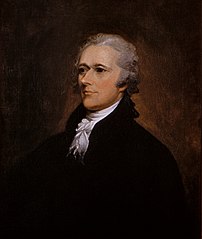
Alexander Hamilton
Alexander Hamilton (born British West Indies, 1757; died Weehawken, New Jersey, July 12, 1804) was an early American leader. He rallied for the causes of the Revolutionary War and served for a while as George Washington’s aide-de-camp. He represented New York at the Constitutional Convention. He was secretary of the treasury while Washington was president and helped the new country become financially sound. He was mortally wounded after a duel with Aaron Burr. Children could learn more at: Alexander Hamilton. Hamilton believed in a strong central government, and he wrote a large portion of The Federalist Papers. Children can read The Federalist Papers at: Project Gutenberg.
Robert C. O’Brien (born Robert Conly in Brooklyn, New York, 1918; died Washington, DC, March 3, 1973) was an editor for National Geographic and a children’s author. He won the 1972 Newbery Medal for Mrs. Frisby and the Rats of NIMH. He started Z for Zachariah, but he died before it was finished. His wife and daughter, following his notes, completed and published the book in 1974. Z for Zachariah received the Jane Addams Children’s Book Award and the Edgar Award in the juvenile division.

Alice Paul
Alice Paul (born Mount Laurel Township, New Jersey, 1885; died Moorestown, New Jersey, July 9, 1977) was a proponent of women’s rights, especially the right to vote. She picketed the White House, much to President Wilson’s chagrin. She was jailed for peacefully protesting, and she went on hunger strikes to bring attention to her cause. After the Nineteenth Amendment (voting rights for women) passed, she turned her attention to including women in the 1964 Civil Rights Act. Children can learn more at: Alice Paul.
Mary Rodgers (born New York, New York, 1931; died New York, New York, June 25, 2014) was a composer of musicals and a writer of children’s books. Her works include Freaky Friday and The Rotten Book.
Ann Tompert (born near Detroit, Michigan, 1918; died Port Huron, Michigan, April 17, 2019) wrote over 50 books. Two fine examples of her books is Grandfather Tang’s Story and Just a Little Bit.




